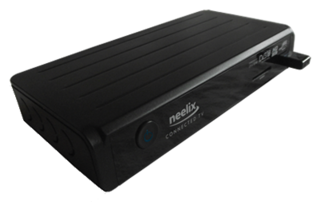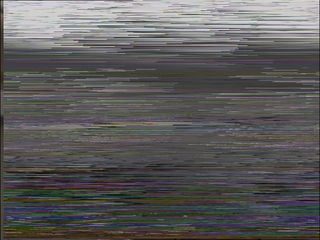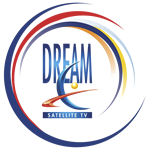
Cable television is a system of delivering television programming to consumers via radio frequency (RF) signals transmitted through coaxial cables, or in more recent systems, light pulses through fibre-optic cables. This contrasts with broadcast television, in which the television signal is transmitted over-the-air by radio waves and received by a television antenna attached to the television; or satellite television, in which the television signal is transmitted over-the-air by radio waves from a communications satellite orbiting the Earth, and received by a satellite dish antenna on the roof. FM radio programming, high-speed Internet, telephone services, and similar non-television services may also be provided through these cables. Analog television was standard in the 20th century, but since the 2000s, cable systems have been upgraded to digital cable operation.

Digital television (DTV) is the transmission of television signals using digital encoding, in contrast to the earlier analog television technology which used analog signals. At the time of its development it was considered an innovative advancement and represented the first significant evolution in television technology since color television in the 1950s. Modern digital television is transmitted in high-definition television (HDTV) with greater resolution than analog TV. It typically uses a widescreen aspect ratio in contrast to the narrower format (4:3) of analog TV. It makes more economical use of scarce radio spectrum space; it can transmit up to seven channels in the same bandwidth as a single analog channel, and provides many new features that analog television cannot. A transition from analog to digital broadcasting began around 2000. Different digital television broadcasting standards have been adopted in different parts of the world; below are the more widely used standards:

A set-top box (STB), also known as a cable box or receiver and historically television decoder or a converter, is an information appliance device that generally contains a TV-tuner input and displays output to a television set and an external source of signal, turning the source signal into content in a form that can then be displayed on the television screen or other display device. They are used in cable television, satellite television, and over-the-air television systems as well as other uses.
Television receive-only (TVRO) is a term used chiefly in North America, South America to refer to the reception of satellite television from FSS-type satellites, generally on C-band analog; free-to-air and unconnected to a commercial DBS provider. TVRO was the main means of consumer satellite reception in the United States and Canada until the mid-1990s with the arrival of direct-broadcast satellite television services such as PrimeStar, USSB, Bell Satellite TV, DirecTV, Dish Network, Sky TV that transmit Ku signals. While these services are at least theoretically based on open standards, the majority of services are encrypted and require proprietary decoder hardware. TVRO systems relied on feeds being transmitted unencrypted and using open standards, which heavily contrasts to DBS systems in the region.

Digital Video Broadcasting (DVB) is a set of international open standards for digital television. DVB standards are maintained by the DVB Project, an international industry consortium, and are published by a Joint Technical Committee (JTC) of the European Telecommunications Standards Institute (ETSI), European Committee for Electrotechnical Standardization (CENELEC) and European Broadcasting Union (EBU).

4DTV is a proprietary broadcasting standard and technology for digital cable broadcasting and C-band/Ku-band satellite dishes from Motorola, using General Instrument's DigiCipher II for encryption. It can tune in both analog VideoCipher 2 and digital DCII satellite channels.
DigiCipher 2, or simply DCII, is a proprietary standard format of digital signal transmission and it doubles as an encryption standard with MPEG-2/MPEG-4 signal video compression used on many communications satellite television and audio signals. The DCII standard was originally developed in 1997 by General Instrument, which then became the Home and Network Mobility division of Motorola, then bought by Google in Aug 2011, and lastly became the Home portion of the division to Arris.
Digital Video Broadcasting - Cable (DVB-C) is the DVB European consortium standard for the broadcast transmission of digital television over cable. This system transmits an MPEG-2 or MPEG-4 family digital audio/digital video stream, using a QAM modulation with channel coding. The standard was first published by the ETSI in 1994, and subsequently became the most widely used transmission system for digital cable television in Europe, Asia and South America. It is deployed worldwide in systems ranging from the larger cable television networks (CATV) down to smaller satellite master antenna TV (SMATV) systems.
Digital cable is the distribution of cable television using digital data and video compression. The technology was first developed by General Instrument. By 2000, most cable companies offered digital features, eventually replacing their previous analog-based cable by the mid 2010s. During the late 2000s, broadcast television converted to the digital HDTV standard, which was incompatible with existing analog cable systems.
Free-to-air (FTA) services are television (TV) and radio services broadcast in unencrypted form, allowing any person with the appropriate receiving equipment to receive the signal and view or listen to the content without requiring a subscription, other ongoing cost, or one-off fee. In the traditional sense, this is carried on terrestrial radio signals and received with an antenna.

Bell Satellite TV is the division of BCE Inc. that provides satellite television service across Canada. It launched on September 10, 1997. As of April 2017, Bell Satellite TV provides over 700 channels to over 1 million subscribers. Its major competitors include satellite service Shaw Direct, as well as various cable and communications companies across Canada.
Pirate decryption is the decryption, or decoding, of pay TV or pay radio signals without permission from the original broadcaster. The term "pirate" is used in the sense of copyright infringement. The MPAA and other groups which lobby in favour of intellectual property regulations have labelled such decryption as "signal theft" even though there is no direct tangible loss on the part of the original broadcaster, arguing that losing out on a potential chance to profit from a consumer's subscription fees counts as a loss of actual profit.

VideoCipher is a brand name of analog scrambling and de-scrambling equipment for cable and satellite television invented primarily to enforce Television receive-only (TVRO) satellite equipment to only receive TV programming on a subscription basis.

Nagravision is a company of the Kudelski Group that develops conditional access systems for digital cable and satellite television. The name is also used for their main products, the Nagravision encryption systems.
Conditional access (CA) is a term commonly used in relation to software and to digital television systems. Conditional access is that ‘just-in-time’ evaluation to ensure the person who is seeking access to content is authorized to access the content. Said another way, conditional access is a type of access management. Access is managed by requiring certain criteria to be met before granting access to the content.

VideoCrypt is a cryptographic, smartcard-based conditional access television encryption system that scrambles analogue pay-TV signals. It was introduced in 1989 by News Datacom and was used initially by Sky TV and subsequently by several other broadcasters on SES' Astra satellites at 19.2° east.
Multi-Choice TV (MCTV) is a television service provider in Barbados. It is a Multichannel Multipoint Distribution Service (MMDS) or DVB-C wireless microwave-based broadcast subscription television provider. They offer a variety of packages which can be considered as comparatively priced to similar providers throughout the world.

Satellite television is a service that delivers television programming to viewers by relaying it from a communications satellite orbiting the Earth directly to the viewer's location. The signals are received via an outdoor parabolic antenna commonly referred to as a satellite dish and a low-noise block downconverter.

A free-to-air or FTA Receiver is a satellite television receiver designed to receive unencrypted broadcasts. Modern decoders are typically compliant with the MPEG-2/DVB-S and more recently the MPEG-4/DVB-S2 standard for digital television, while older FTA receivers relied on analog satellite transmissions which have declined rapidly in recent years.

Dream Satellite TV was the first all-digital Direct-To-Home (DTH) television broadcasting service via satellite in the Philippines. Broadcasting from the Dream Broadcast Center located at the Clark Special Economic Zone in Pampanga. Content is received from program providers, compressed and broadcast via Koreasat 5 in DVB-S and NTSC color format exclusively to its subscribers using the Integrated Receiver-Decoder and the Conax/Nagravision 3 Encryption System.












